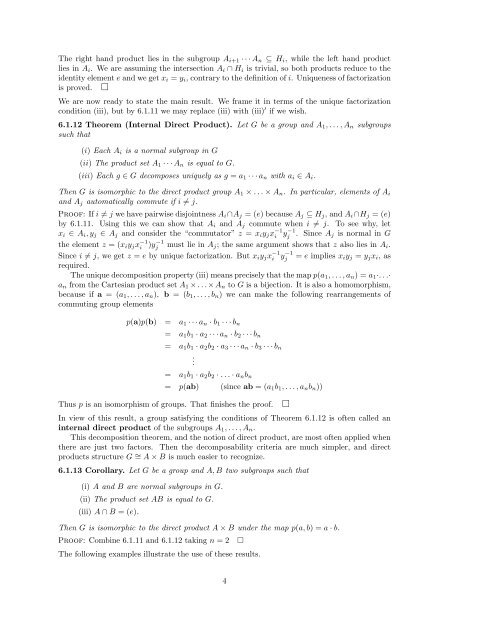Algebra I: Section 6. The structure of groups. 6.1 Direct products of ...
Algebra I: Section 6. The structure of groups. 6.1 Direct products of ...
Algebra I: Section 6. The structure of groups. 6.1 Direct products of ...
Create successful ePaper yourself
Turn your PDF publications into a flip-book with our unique Google optimized e-Paper software.
<strong>The</strong> right hand product lies in the subgroup Ai+1 · · · An ⊆ Hi, while the left hand product<br />
lies in Ai. We are assuming the intersection Ai ∩ Hi is trivial, so both <strong>products</strong> reduce to the<br />
identity element e and we get xi = yi, contrary to the definition <strong>of</strong> i. Uniqueness <strong>of</strong> factorization<br />
is proved. �<br />
We are now ready to state the main result. We frame it in terms <strong>of</strong> the unique factorization<br />
condition (iii), but by <strong>6.</strong>1.11 we may replace (iii) with (iii) ′ if we wish.<br />
<strong>6.</strong>1.12 <strong>The</strong>orem (Internal <strong>Direct</strong> Product). Let G be a group and A1, . . . , An sub<strong>groups</strong><br />
such that<br />
(i) Each Ai is a normal subgroup in G<br />
(ii) <strong>The</strong> product set A1 · · ·An is equal to G.<br />
(iii) Each g ∈ G decomposes uniquely as g = a1 · · · an with ai ∈ Ai.<br />
<strong>The</strong>n G is isomorphic to the direct product group A1 × . . . × An. In particular, elements <strong>of</strong> Ai<br />
and Aj automatically commute if i �= j.<br />
Pro<strong>of</strong>: If i �= j we have pairwise disjointness Ai ∩Aj = (e) because Aj ⊆ Hj, and Ai ∩Hj = (e)<br />
by <strong>6.</strong>1.11. Using this we can show that Ai and Aj commute when i �= j. To see why, let<br />
xi ∈ Ai, yj ∈ Aj and consider the “commutator” z = xiyjx −1<br />
i y−1<br />
j . Since Aj is normal in G<br />
the element z = (xiyjx −1<br />
i )y −1<br />
j must lie in Aj; the same argument shows that z also lies in Ai.<br />
Since i �= j, we get z = e by unique factorization. But xiyjx −1<br />
i y−1 j = e implies xiyj = yjxi, as<br />
required.<br />
<strong>The</strong> unique decomposition property (iii) means precisely that the map p(a1, . . .,an) = a1·. . .·<br />
an from the Cartesian product set A1 ×. . .×An to G is a bijection. It is also a homomorphism,<br />
because if a = (a1, . . . , an), b = (b1, . . . , bn) we can make the following rearrangements <strong>of</strong><br />
commuting group elements<br />
p(a)p(b) = a1 · · ·an · b1 · · · bn<br />
= a1b1 · a2 · · ·an · b2 · · · bn<br />
= a1b1 · a2b2 · a3 · · ·an · b3 · · · bn<br />
.<br />
= a1b1 · a2b2 · . . . · anbn<br />
= p(ab) (since ab = (a1b1, . . . , anbn))<br />
Thus p is an isomorphism <strong>of</strong> <strong>groups</strong>. That finishes the pro<strong>of</strong>. �<br />
In view <strong>of</strong> this result, a group satisfying the conditions <strong>of</strong> <strong>The</strong>orem <strong>6.</strong>1.12 is <strong>of</strong>ten called an<br />
internal direct product <strong>of</strong> the sub<strong>groups</strong> A1, . . . , An.<br />
This decomposition theorem, and the notion <strong>of</strong> direct product, are most <strong>of</strong>ten applied when<br />
there are just two factors. <strong>The</strong>n the decomposability criteria are much simpler, and direct<br />
<strong>products</strong> <strong>structure</strong> G ∼ = A × B is much easier to recognize.<br />
<strong>6.</strong>1.13 Corollary. Let G be a group and A, B two sub<strong>groups</strong> such that<br />
(i) A and B are normal sub<strong>groups</strong> in G.<br />
(ii) <strong>The</strong> product set AB is equal to G.<br />
(iii) A ∩ B = (e).<br />
<strong>The</strong>n G is isomorphic to the direct product A × B under the map p(a, b) = a · b.<br />
Pro<strong>of</strong>: Combine <strong>6.</strong>1.11 and <strong>6.</strong>1.12 taking n = 2 �<br />
<strong>The</strong> following examples illustrate the use <strong>of</strong> these results.<br />
4

















